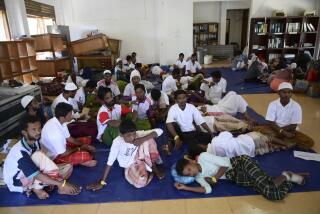Refugees : Tide of ‘Boat People’ Is Ebbing : But harsh conditions at home still drive many Vietnamese to leave, only to find doors closing to them abroad.
- Share via
HONG KONG — More than 30,000 people fled Vietnam in 1990 as “boat people,” washing up as far away as the islands of Indonesia. Despite the huge size of the continuing exodus, the overall number of asylum-seekers was actually down compared to the previous two years.
The decline in the number of refugees has many explanations: a virtual halt to asylum-seekers who are leaving Vietnam and a flood of propaganda about the hardships awaiting emigrants. In many parts of Asia, the door is simply slamming shut to them.
Vietnam’s economic situation continues to deteriorate, with large-scale unemployment. This year’s refugee departures, although fewer than in 1989 and 1988, are still higher than in any year since 1982. As time passes, it is harder for applicants to make a good case that they have suffered because of their association with the old South Vietnamese regime.
Hong Kong is a good example of the new trend. Last year, a flood of 34,622 Indochinese refugees swept into the colony, overwhelming its facilities. Nearly all the new arrivals were from just four districts of northern Vietnam near Haiphong.
This year, only 6,000 asylum-seekers have turned up, with only 500 coming from northern Vietnam. Of the remainder, mostly ethnic Chinese, a few hundred now travel by land routes through China, earning them the mocking Hong Kong sobriquet of “bus people.” But they are a tiny minority.
According to refugee officials and aid workers, the people of northern Vietnam, at least, have finally gotten the message that escape from Vietnam now means confinement in a detention camp rather than resettlement in California. That alone appears to have deterred thousands from leaving Vietnam this year.
Despite the decline in arrivals, the population of Hong Kong’s detention centers has swollen to 52,953, with the increase in population (6,034 new arrivals and 2,500 births) hardly offset by the 5,700 camp inmates who volunteered to go home rather than face more time in confinement.
“We are desperately trying to maintain temporary asylum in a region which is fed up with it,” said Hong Kong’s refugee coordinator, Clinton Leeks.
That frustration is evident in such Southeast Asian nations as Malaysia, which since June has regularly towed boatloads of Vietnamese out to sea and handed them maps to Indonesia, and the Philippines. In July, however, the Philippines unofficially stopped accepting refugees plucked from the sea by passing ships.
In addition to Malaysia and the Philippines, Singapore and Taiwan are no longer accepting sea-rescue cases. With Indonesia’s refugee camp at Galang bulging with more than 19,000 asylum-seekers, Western aid officials worry that the Jakarta government may be the next to stop offering shelter.
The problem is largely a dispute between the Asian nations and the United States over a passage in the 1989 Comprehensive Plan of Action that was adopted to deal with the growing tide of would-be emigrants. The plan provides for screening arrivals to determine if they are genuine political refugees or merely economic migrants looking for a better life.
Everyone agrees that the genuine refugees should be resettled, but the rejected refugees are at the heart of the dispute. Hong Kong, Malaysia and other countries want to send them back home. The United States and, ironically, Vietnam vehemently oppose forced repatriation as inhumane.
In September, the Office of the U.N. High Commissioner for Refugees reached agreement with Hong Kong, Britain and Vietnam to try a new tactic: to send home asylum-seekers who did not volunteer but who also did not object to being sent back.
Refugee officials from around the region closely watched the Hong Kong experiment. If it worked, the plan would be implemented elsewhere. So far, it has flopped. Only 23 people were sent back in the first group of “non-objectors” despite promises of equal treatment with volunteers. Back in Hanoi, they were horrified to hear Vietnamese officials threatening terms in re-education camps to non-objectors who step out of line.
Perhaps most daunting of all, Hong Kong’s program of screening prospective refugees is being tested in a court case that could wind up invalidating many of the 16,000 screenings which have already taken place.
More to Read
Sign up for Essential California
The most important California stories and recommendations in your inbox every morning.
You may occasionally receive promotional content from the Los Angeles Times.










